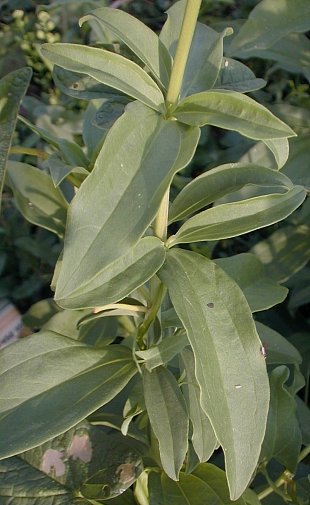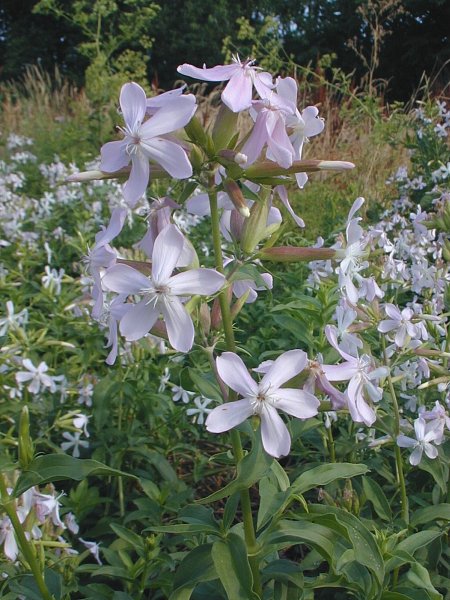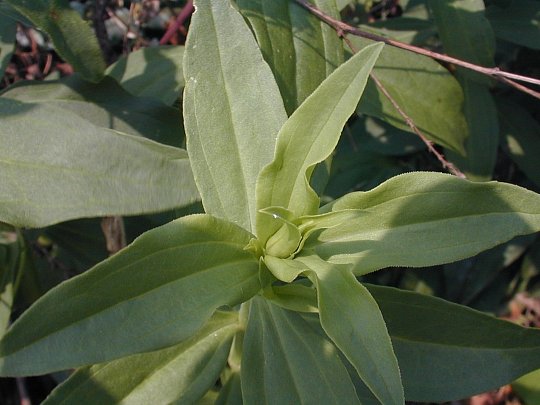Description: This herbaceous perennial plant is about 1–2½' tall and more or less erect. From the axils of the upper leaves, some short side stems are produced, otherwise it is little branched. The stems are round and hairless. The opposite leaves are up to 4" long and 1¾" across. They are ovate or broadly lanceolate, smooth along the margins, and hairless. There are 3 conspicuous veins on the upper surface of the larger leaves. The leaves are sessile against the stem, otherwise they have short broad petioles. The central stem and some of the uppermost side stems terminate in small clusters of flowers.

Each flower is about ¾–1" across, consisting of a long cylindrical calyx that is green and a corolla with 5 spreading petals that are white or light pink. The calyx is hairless and about 1" long. At the base of each petal, there are 2 claws that are small and slender. The 10 stamens are strongly exerted from the throat of the corolla; they are white with pale yellow anthers. As the flowers age, the petals begin to curve backward. The blooming period occurs during the summer and lasts about 2 months. There is a pleasant floral scent. A sack-like capsule of seeds lies within the calyx of each flower. These seeds are somewhat flat and nearly round along the perimeter, with an outer surface that is granular or pebble-like. The root system produces abundant orange rhizomes. This plant spreads by reseeding itself and vegetatively through the rhizomes. It often forms colonies.

Cultivation:
The
preference is full or partial sun and moist to slightly dry conditions.
It is not fussy about soil characteristics, and can be found in soil
that is loamy, gravelly, or sandy. This plant is easy to grow and has
few problems with insects and disease. It is also spreads aggressively,
forming dense colonies that exclude other species of plants.
Range & Habitat:
The non-native Soapwort is a common plant that occurs in most counties
of Illinois
(see Distribution
Map). It was originally introduced into the United States
from Europe for horticultural purposes. Habitats include sloping banks
of streams, gravel bars and sand bars along streams, areas along
roadsides and railroads, prairie remnants along railroads, weedy
meadows, and waste areas. Soapwort is still cultivated in flowerbeds
and herbal gardens. While this plant is typically found in disturbed
areas, it also occurs in some natural areas, where it can become a pest.

Faunal
Associations:
The nectar of the flowers attracts butterflies and moths, including the
butterflies Pontia protodice (Checkered White) and Euptoieta
claudia (Variegated Fritillary). Considering the abundance of
the flowers, these insect visitors are relatively few. Similarly, the
seeds appear to be of little use by birds as a food source. The
bitter-tasting foliage is high in saponins and toxic to mammalian
herbivores. These saponins can cause gastrointestinal irritation and
the breakdown of red blood cells. Therefore, the foliage is rarely
eaten by such animals. The overall value of Soapwort to wildlife is low.
Photographic Location:
Along a railroad in Urbana, Illinois, where a large colony of plants
has persisted for several years.

Comments: Soapwort is an attractive plant with a long blooming period. Unfortunately, it has also become an invasive plant in some natural areas. It is easy to identify among the various members of the Pink family because the white to pink flowers are large-sized and the foliage is hairless. A distinctive characteristic is the pair of long slender claws at the base of each flower petal. Another common name for this plant is "Bouncing Bet," which is an old expression for a laundry woman. The juice of the flowering stems and rhizomes is high in saponins; when added to water, it produces a mild soapy lather that can be used to wash clothes.